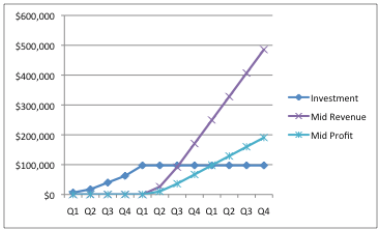This is the next blog in my Igniting Growth Series where I capture and share some of the wisdom, I’ve gained over my 30 years in CEO/President positions and pass on the knowledge gained from the CEOs I’ve worked with in an advisory capacity. My goal is to provide simple, easy-to-implement insights/ideas to ignite success in your business. This next post focuses on how a Return Map can help track and improve your efforts to innovate.
In working with a local organization, I picked up the idea of the Return Map and how it can be leveraged to drive organizational success. At its core, the Return Map is a simple tool (typically an excel spread sheet) that captures the lifecycle of a new product from idea through end-of-life. The focus of the Return Map however is on understanding the success (or lack of) of a product as measured by return on the investment (ROI) and the time it takes to get to positive returns.
When used effectively the Return Map is much more than a simple tracking tool – it’s an instrument to help provide focus on idea investment. It should engage all operational parts of the company and through feedback help drive future success.
There are several areas of focus to consider when making idea investment decisions:
 |
Investigation. What’s the problem being solved? What’s the competitive landscape? Is there an opportunity to differentiate to 10X? Perform a SWOT analysis. A Product Requirements Document (PRD) is often the result (formal or informal) of this stage. R&D needs to identify the resources needed and time – aka how much will it cost and when will it be RTA (Ready to Announce) Marketing and Sales owns creating a forecast (probably a range), based on the identification of the above factors and R&D’s feedback on timing. Operations need to identify any specific investments, if any are needed and when they can support orders (RTO). |
In an older HBR article “The Return Map: Tracking Product Teams” HP was identified as a proponent of the Return Map for measuring innovation results. In that article, it stated that ownership of the return map should be product line manager (PLM) or the business unit head.
As the project execution of an idea proceeds, PLMs should routinely track the actuals against the original forecast. Any corrections should be identified, discussed and actions taken if needed (perhaps the program should be changed as new info surfaces). Ideally using a Return Map process results in a successful product introduction and over time, develops strong positive returns.
Once a product is launched that is not the end. Use the results and feedback (good or bad) to drive improvements to the innovation process and execution side of your business. Too often this later stage of examining the results and feedback is missed and the lessons to be learned, are not learned and we can continue to make costly errors. Driving a discipline of idea management into the Return Map at every stage is critical to future success.
Up Next on Igniting Growth: The Evolving Pivot.
This article was published more than 1 year ago. Some information may no longer be current.

